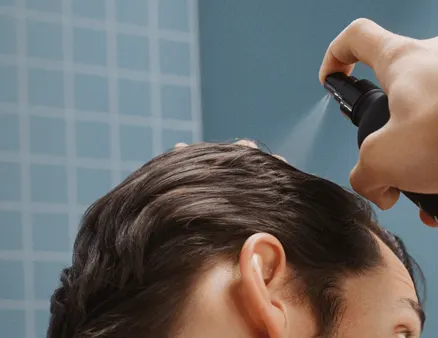Here's what we'll cover
Here's what we'll cover
Here's what we'll cover
Did you know that up to 50% of men and women will experience hair loss by age 50? The most common cause of progressive hair loss is androgenetic alopecia (better known as male pattern baldness or female pattern baldness) (Ho, 2021).
There are many treatments for hair loss, and minoxidil is chief among the over-the-counter (OTC) options. It’s a topical solution that works well for many people, but it can commonly cause hair shedding when people first start using it—just for a short time.
Below, we’ll cover how common it is to experience hair loss while taking minoxidil, how long it lasts, and other side effects you can expect from this OTC medication.
What is minoxidil (Rogaine)?
Minoxidil—brand name Rogaine—is a popular hair loss treatment for both men and women. You can use this product as either a gel or foam, typically applied daily directly to the area of your scalp with noticeable hair loss.
Originally developed to treat hypertension, researchers observed that people with hair loss who used minoxidil to treat their high blood pressure experienced hair regrowth. While minoxidil doesn’t work for everyone, it does successfully decrease hair loss and increase hair growth in many people.
While it’s not totally clear how minoxidil works, we do know this drug is a vasodilator—meaning it dilates your blood vessels so that blood flows more easily where it’s applied. Increased blood circulation to your scalp may stimulate hair growth (Badri, 2021).
Oral Minoxidil Important Safety Information: Read more about serious warnings and safety info.
What causes minoxidil hair shedding?
Minoxidil affects the hair growth cycle, accelerating the part of the process during which your thinning hair falls out. This shedding allows the old hair to fall out, making way for new, healthier hair to take its place. To understand, let’s take a more in-depth look at the hair growth cycle.
There are four different stages of hair growth:
Anagen phase—This is the growth phase of the hair growth cycle. This is when your hair follicles push hairs out from the root.
Catagen phase—The catagen phase is a transitional phase, where your hair stops growing.
Telogen phase—During the telogen phase, your hair is in a resting phase, where it’s done growing but not yet ready to fall out.
Exogen phase—During the exogen phase, your old hair falls out, and your new hair grows in.

Taking minoxidil affects two stages of the hair growth process—the anagen phase and the telogen phase. While minoxidil extends the length of the anagen phase, it shortens the length of the telogen phase (Badri, 2021).
Because minoxidil speeds up the resting phase of the hair growth cycle, sometimes your hair will fall out faster than it normally would, and shedding is expected, at least initially.
How long does minoxidil shedding last?
For those taking minoxidil or Rogaine, the amount of initial shedding will vary from person to person. In general, minoxidil shedding can last up to 8 weeks, after which you start noticing results. However, it may take up to four months to see the maximal effects of decreased hair loss and new hair growth (Badri, 2021).
If you notice that you continue to experience shedding after four months, minoxidil might not be the right product for you, or something else may be causing your hair loss. Talk to your healthcare provider about alternative treatments.
Can you prevent minoxidil shedding?
While there’s not much you can do to prevent minoxidil shedding—or even predict if you’ll experience shedding at all—it’s good to know that the higher the concentration of minoxidil you use, the more powerful the side effects are likely to be.
Minoxidil comes in concentrations of 2 and 5%, and the lower concentrations may cause fewer side effects. If you’re experiencing some unwanted side effects, you can always talk to your provider or dermatologist about switching to a lower concentration.
Other minoxidil side effects
In addition to shedding, a few other common side effects are associated with minoxidil. These include (Badri, 2021):
Scalp itching
Flaking, irritated skin
Scalp folliculitis
Hypertrichosis
When using any type of topical product that includes minoxidil, a certain amount of shedding is expected and is even normal. In fact, it’s actually a good sign that the product is working and doing what it’s supposed to.
But if this shedding doesn't stop within four months, speak with your healthcare provider. It may be time for you to discontinue minoxidil and find another product that will work better for you and your hair.
DISCLAIMER
If you have any medical questions or concerns, please talk to your healthcare provider. The articles on Health Guide are underpinned by peer-reviewed research and information drawn from medical societies and governmental agencies. However, they are not a substitute for professional medical advice, diagnosis, or treatment.
References
Badri, T., Nessel, T. A., & Kumar, D. D. (2021). Minoxidil. StatPearls . Retrieved on July 18, 2022 from https://www.ncbi.nlm.nih.gov/books/NBK482378/
Ho, C. H., Sood, T., & Zito, P. M. (2021). Androgenetic alopecia. StatPearls . Retrieved on Aug 1, 2022 from https://www.ncbi.nlm.nih.gov/books/NBK430924/
Rhodes, T., Girman, C. J., Savin, R. C., et al. (1998). Prevalence of male pattern hair loss in 18-49 year old men. Dermatology & Surgery; 24 (12), 1330-2. doi:10.1111/j.1524-4725.1998.tb00009.x. Retrieved from https://pubmed.ncbi.nlm.nih.gov/9865198/










